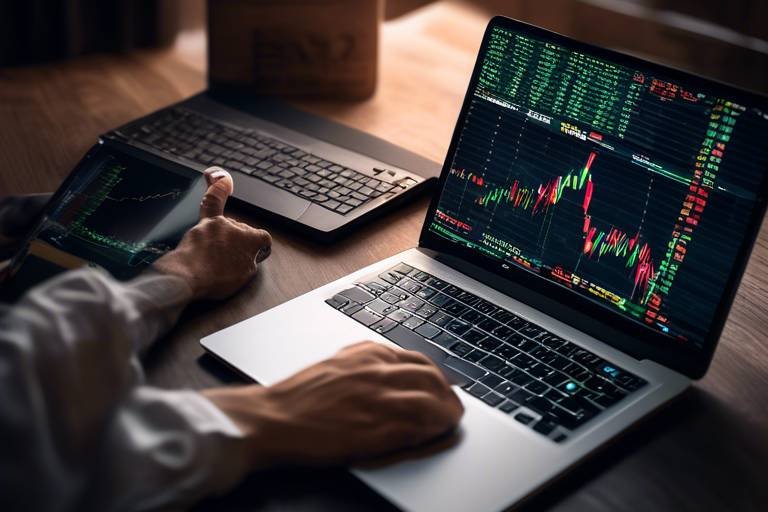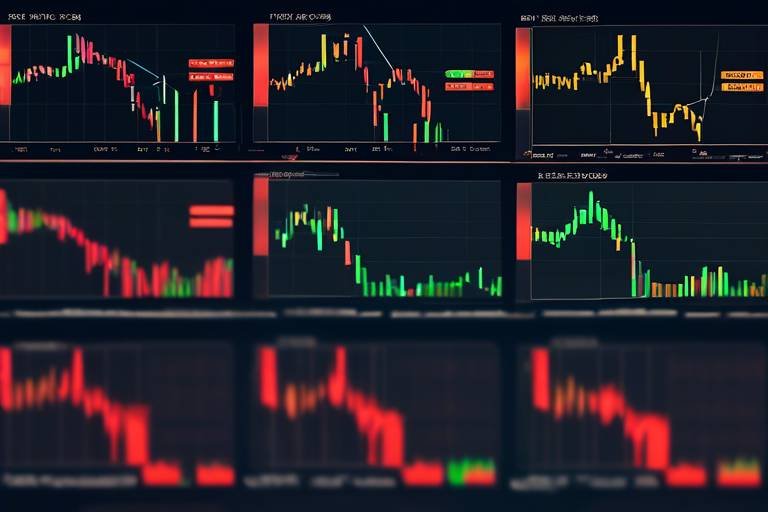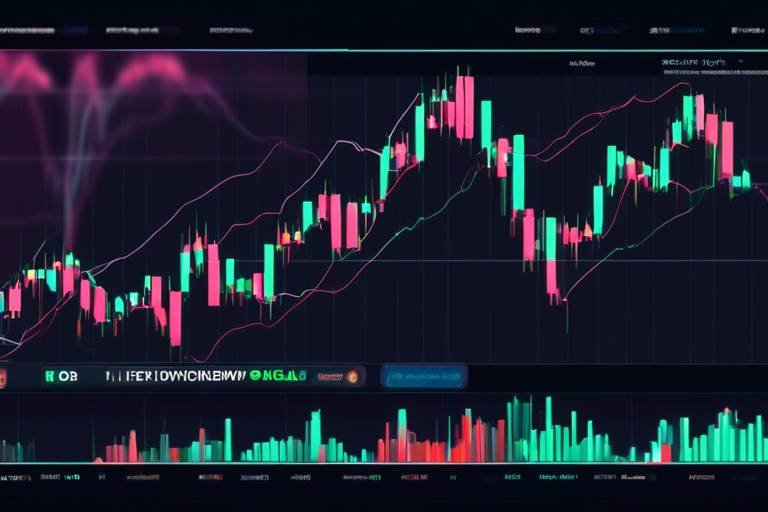How to Develop a Technical Trading Strategy for Altcoins
Creating a successful technical trading strategy for altcoins is not just about knowing the market; it’s about understanding the intricacies of trading itself. With the rapid rise of altcoins, many traders are eager to dive into this exciting world, but it’s essential to have a solid strategy in place. This article will guide you through the essential components of developing a technical trading strategy that can help you navigate the volatile waters of altcoin trading.
Altcoins, or alternative coins to Bitcoin, encompass a wide variety of cryptocurrencies, each with unique features and market behaviors. Unlike Bitcoin, which is often seen as a digital gold, altcoins can offer traders a plethora of opportunities due to their diverse applications and innovative technologies. Some altcoins might focus on enhancing transaction speeds, while others aim to provide smart contract capabilities or decentralized finance solutions. Understanding these differences is crucial for traders who wish to capitalize on the potential of these assets.
Moreover, the market behavior of altcoins can be quite different from Bitcoin. They are generally more volatile, which means that while they can lead to significant profits, they can also result in substantial losses. This unpredictability is where a well-crafted trading strategy becomes invaluable. By analyzing market trends and understanding the underlying technology of various altcoins, traders can identify potential opportunities that align with their risk tolerance and investment goals.
Technical analysis is the backbone of any trading strategy. It involves examining price movements and trading volumes to forecast future price actions. For altcoin traders, mastering the fundamentals of technical analysis is vital. Key concepts include identifying trends, recognizing support and resistance levels, and understanding chart patterns. These elements are essential for making informed trading decisions in the fast-paced altcoin market.
Recognizing chart patterns is crucial for predicting price trends. Common patterns such as head and shoulders, triangles, and flags can provide valuable insights into market behavior. For instance, a head and shoulders pattern often indicates a reversal in trend, signaling that it might be time to exit a position or enter a short. By learning to identify these formations, traders can make better decisions based on historical price movements.
Trend lines are essential tools for identifying market direction. Drawing trend lines involves connecting the highs or lows of price movements, which helps traders visualize potential entry and exit points. For instance, if the price consistently bounces off a trend line, it may indicate a strong support level, suggesting it could be a good time to buy. Conversely, if the price breaks through a trend line, it might signal a shift in market sentiment.
Support and resistance levels are critical in understanding price barriers. Support levels indicate where a downtrend may pause due to a concentration of buying interest, while resistance levels show where an uptrend might stall because of selling pressure. Identifying these levels can help traders make informed decisions about when to enter or exit trades. For example, if an altcoin approaches a strong resistance level, it might be wise to take profits or set a stop-loss order.
Various technical indicators assist traders in analyzing market conditions. Popular tools such as Moving Averages, Relative Strength Index (RSI), and Moving Average Convergence Divergence (MACD) provide valuable insights into price trends and momentum. For instance, the RSI can help traders identify overbought or oversold conditions, signaling potential reversals. By effectively incorporating these indicators into their trading strategies, traders can enhance their decision-making process.
Effective risk management is vital in trading to preserve capital and minimize losses. Altcoin trading can be particularly risky due to its volatility, making it essential for traders to implement robust risk management strategies. Techniques such as position sizing, stop-loss orders, and risk-reward ratios are critical components of a successful trading plan. For instance, setting a stop-loss order helps limit potential losses, allowing traders to maintain their capital for future trades.
A well-structured trading plan is essential for consistent success. This plan should include specific goals, strategies, and performance evaluation techniques tailored to altcoin trading. By clearly defining what you want to achieve and how you plan to do it, you can create a roadmap that guides your trading decisions. Regularly reviewing and adjusting your plan based on market conditions and personal performance is also crucial for long-term success.
Trading psychology plays a significant role in decision-making. The emotional aspects of trading, such as managing fear and greed, can significantly impact your performance. Successful traders understand the importance of discipline and emotional control when executing their strategies. By developing a mindset that prioritizes rational decision-making over emotional reactions, traders can improve their chances of success in the altcoin market.
- What are altcoins? Altcoins are cryptocurrencies other than Bitcoin, often with unique features and purposes.
- Why is technical analysis important for trading altcoins? Technical analysis helps traders understand price movements and make informed decisions based on historical data.
- What are some common chart patterns used in altcoin trading? Common patterns include head and shoulders, triangles, and flags.
- How can I manage risk while trading altcoins? Implement strategies like position sizing, stop-loss orders, and maintaining a favorable risk-reward ratio.

Understanding Altcoins
Altcoins, short for alternative coins, represent a vibrant and diverse range of cryptocurrencies that extend beyond Bitcoin. While Bitcoin is often seen as the pioneer of the crypto world, altcoins have emerged to fill various niches, offering unique features and functionalities. These digital assets can be anything from tokens that facilitate smart contracts, like Ethereum, to stablecoins pegged to fiat currencies, such as Tether. The sheer variety of altcoins can be overwhelming, but understanding their characteristics is crucial for any trader looking to capitalize on opportunities in the crypto market.
One of the key aspects that differentiate altcoins from Bitcoin is their market behavior. Altcoins often exhibit higher volatility compared to Bitcoin, which can be both a blessing and a curse. On one hand, this volatility can lead to significant profit opportunities; on the other hand, it can also result in substantial losses if not managed correctly. For instance, while Bitcoin might experience price fluctuations of a few percentage points in a day, some altcoins can swing by double digits, making them attractive for traders with a high-risk tolerance.
Moreover, altcoins can be valuable assets for traders for several reasons:
- Diversification: Including a variety of altcoins in a trading portfolio can help spread risk and enhance potential returns.
- Innovative Technologies: Many altcoins are built on cutting-edge technologies that solve real-world problems, offering traders a chance to invest in the future.
- Market Opportunities: The altcoin market is often less saturated than Bitcoin, providing unique opportunities for traders to identify undervalued assets.
Understanding the fundamentals of altcoins can significantly enhance a trader's ability to navigate the crypto landscape. By analyzing the specific use cases and market dynamics of different altcoins, traders can make informed decisions that align with their investment strategies. Additionally, being aware of the risks associated with altcoins is essential. Many altcoins lack the stability and established market presence of Bitcoin, which can lead to sudden price drops or even the failure of a project altogether. Therefore, thorough research and due diligence are critical before diving into altcoin trading.
In summary, altcoins offer a diverse array of investment opportunities within the cryptocurrency ecosystem. By understanding their characteristics and market behavior, traders can better position themselves to take advantage of the unique benefits that altcoins provide. Whether you’re looking for high-risk, high-reward investments or stable assets to hold long-term, the altcoin market has something to offer for everyone.

Technical Analysis Fundamentals
When diving into the world of altcoin trading, understanding technical analysis is like having a treasure map in your hands. It guides you through the chaotic seas of cryptocurrency price movements, helping you forecast potential future actions based on historical data. At its core, technical analysis is about studying price movements and trading volumes. By analyzing these elements, traders can identify patterns and trends that often repeat themselves, providing valuable insights into where the market might head next.
One of the foundational concepts of technical analysis is recognizing trends. Trends can be categorized into three main types: uptrends, downtrends, and sideways trends. An uptrend indicates that prices are generally rising, while a downtrend suggests a decline. Sideways trends occur when prices move within a relatively stable range. Understanding these trends is crucial because they help traders make informed decisions on when to enter or exit a position. Imagine surfing; you want to catch the wave at the right moment, not just any wave!
Another critical aspect of technical analysis involves identifying support and resistance levels. Support is the price level at which an asset tends to stop falling and may bounce back up, while resistance is where the price tends to stop rising and may fall back down. These levels act like invisible barriers in the market. For instance, if an altcoin consistently bounces off a support level, it suggests that buyers are stepping in at that price point. Conversely, if a price repeatedly hits a resistance level, it indicates that sellers are taking control. Understanding these levels can be the difference between a profitable trade and a costly mistake.
Recognizing chart patterns is essential for predicting price trends in altcoin trading. Chart patterns are formations created by the price movements of an asset on a chart. Some of the most common patterns include:
- Head and Shoulders: This pattern signals a reversal in trend. It consists of three peaks: a higher peak (head) between two lower peaks (shoulders).
- Triangles: These can be ascending, descending, or symmetrical and indicate a period of consolidation before a breakout.
- Flags: Flags are short-term continuation patterns that resemble a flag on a pole, indicating a brief pause before the trend resumes.
By learning to recognize these patterns, traders can make educated predictions about future price movements, enhancing their decision-making process.
Trend lines are invaluable tools for any trader. Drawing a trend line involves connecting the lows in an uptrend or the highs in a downtrend. These lines help to visualize market direction and can also act as dynamic support and resistance levels. For instance, if the price of an altcoin is consistently bouncing off a trend line, it suggests a strong trend is in place. Traders often look for opportunities to buy near the trend line during an uptrend or sell near it during a downtrend. This technique is akin to using a compass; it helps you stay on the right path amidst market fluctuations.
Identifying support and resistance levels is crucial for making informed trading decisions. These levels can be determined through historical price action, where traders look for areas where the price has previously reversed. For example, if an altcoin has bounced off a certain price point multiple times, that point may be considered a strong support level. Conversely, if the price has struggled to break above a specific level, it may be seen as resistance. Understanding these levels can help traders set entry and exit points, ultimately leading to more disciplined trading practices.
To enhance their technical analysis, traders often utilize various indicators and tools. Popular indicators include:
- Moving Averages: These smooth out price data to identify trends over a specific period.
- Relative Strength Index (RSI): This momentum oscillator measures the speed and change of price movements, helping to identify overbought or oversold conditions.
- Moving Average Convergence Divergence (MACD): This trend-following momentum indicator shows the relationship between two moving averages of a security's price.
Incorporating these tools into your trading strategy can provide additional clarity and help you make more informed decisions in the volatile altcoin market.

Chart Patterns
Recognizing is crucial for predicting price trends in the altcoin market. Just like a detective piecing together clues, traders use these patterns to forecast potential price movements. Imagine you’re watching a movie where the plot twists keep you on the edge of your seat; that’s how chart patterns can keep traders engaged and ready to act. By identifying these patterns, traders can make informed decisions about when to enter or exit a trade.
There are several common chart patterns that every trader should be aware of. Each pattern tells a story about market sentiment and potential future movements. Here are a few key patterns:
- Head and Shoulders: This pattern often signals a reversal in trend. It consists of three peaks: a higher peak (head) between two lower peaks (shoulders). When the price breaks below the neckline, it can indicate a bearish trend.
- Triangles: Triangles can be ascending, descending, or symmetrical. They represent periods of consolidation before a breakout. Traders often look for a breakout direction to decide their next move.
- Flags: Flags are short-term continuation patterns that resemble a flag on a pole. They indicate a brief pause in the prevailing trend, often followed by a continuation in the same direction.
Understanding these patterns is like having a roadmap for your trading journey. For instance, when you spot a head and shoulders pattern forming, it’s akin to seeing dark clouds gathering before a storm; it suggests that a price drop could be imminent. Conversely, spotting a bullish flag can be compared to a sprinter getting ready to take off after a brief rest; it indicates that the price may continue to rise after a brief consolidation.
Now, how do traders leverage these formations for better decision-making? It’s all about timing and context. For example, if a trader identifies a bullish triangle pattern, they might set a buy order just above the resistance level, anticipating a breakout. However, it’s essential to combine chart patterns with other analysis methods, such as trend lines and indicators, to confirm signals and reduce the risk of false breakouts.
In conclusion, mastering chart patterns is an invaluable skill for altcoin traders. Just as a seasoned chef knows the perfect recipe for a delicious dish, a skilled trader knows how to interpret these patterns to create a winning strategy. By honing your ability to recognize and act on these patterns, you can navigate the unpredictable waters of the altcoin market with greater confidence.
Q: What are chart patterns?
A: Chart patterns are formations created by the movement of price over time on a chart. They help traders predict future price movements based on historical patterns.
Q: How do I identify a head and shoulders pattern?
A: A head and shoulders pattern consists of three peaks: the first shoulder is a smaller peak, the head is a larger peak, and the second shoulder is similar in size to the first. The neckline is drawn at the lowest point between the shoulders.
Q: Can I rely solely on chart patterns for trading decisions?
A: While chart patterns are a valuable tool, it’s important to use them in conjunction with other analysis methods, such as trend lines and indicators, to confirm your trading signals.

Trend Lines
When diving into the world of altcoin trading, one of the first tools you should become familiar with is the trend line. Think of trend lines as the compass for your trading journey; they help you navigate the often tumultuous waters of the cryptocurrency market. A trend line is simply a straight line that connects two or more price points, allowing traders to visualize the direction in which a particular altcoin is moving. By identifying the slope of the trend line, you can easily determine whether the market is in an uptrend, downtrend, or moving sideways.
To draw a trend line, you should start by identifying at least two significant price points on a chart. For an uptrend, connect the lowest points (the lows) of the price action, and for a downtrend, connect the highest points (the highs). The more points you connect, the stronger the trend line becomes. This is crucial because a strong trend line can act as a reliable indicator of future price movements. A break below an uptrend line might signal a reversal, while a break above a downtrend line could indicate a bullish shift.
But why stop at just drawing lines? Understanding how to interpret them is equally important. For instance, when prices consistently bounce off a trend line, it often signifies a strong support or resistance level. This means that traders can use these points to make informed decisions about when to enter or exit trades. Imagine you're a surfer waiting for the perfect wave; the trend line helps you catch that wave at just the right moment.
Here’s a quick summary of how to effectively use trend lines in your trading strategy:
- Identify the trend: Determine whether the market is in an uptrend, downtrend, or sideways movement.
- Draw the trend line: Connect at least two significant price points to visualize the trend.
- Watch for bounces: Look for price action that consistently bounces off the trend line, indicating strong support or resistance.
- Adjust as necessary: As new price data comes in, don't hesitate to redraw your trend lines to reflect the current market conditions.
In conclusion, mastering trend lines can significantly enhance your trading strategy for altcoins. They provide a clear visual representation of market trends, helping you make more informed decisions. Just like a seasoned sailor relies on a map to navigate the seas, you too can rely on trend lines to steer your trading journey towards success.
- What is the best way to draw trend lines? Start by identifying at least two significant price points, then connect them with a straight line. Make sure to adjust as new data comes in.
- Can trend lines be used on any time frame? Yes, trend lines can be applied to any time frame, whether you're day trading or looking at longer-term investments.
- What happens if a price breaks a trend line? A break can indicate a potential reversal or continuation of the trend, so it's essential to reassess your trading strategy.

Support and Resistance Levels
Understanding is crucial for anyone looking to navigate the volatile waters of altcoin trading. These levels act as psychological barriers where the price of an altcoin tends to pause or reverse. Think of them as the invisible walls of a boxing ring; they contain the price action and can dictate the market's next move. When traders identify these levels, they can make more informed decisions about when to enter or exit a trade.
Support levels are price points where a downward trend can be expected to pause due to a concentration of demand. In other words, it's where buyers step in and say, "Hey, this price looks good to me!" On the flip side, resistance levels are where selling interest emerges, creating a ceiling that the price struggles to break through. Imagine trying to push a balloon underwater; it may go down, but it will always try to float back up. If you can identify these key levels, you can anticipate potential price movements and make strategic trading choices.
To identify these levels effectively, traders often look for historical price points where the price has reversed multiple times. A good practice is to draw horizontal lines on your charts at these levels. This visual representation allows you to see where the price has struggled in the past, giving you clues about future behavior. It's essential to remember that these levels are not set in stone; they can shift based on market dynamics and new information. As a trader, staying flexible and adapting to these changes is vital.
Here's a simple table to illustrate how support and resistance levels can be identified on a price chart:
| Level Type | Price Action | Indicators |
|---|---|---|
| Support | Price tends to bounce back up | Previous low points, moving averages |
| Resistance | Price tends to reverse downwards | Previous high points, Fibonacci retracement |
In addition to historical price points, traders can also use various technical indicators to confirm these levels. For instance, moving averages can act as dynamic support and resistance levels. If the price is above a moving average, that average can serve as a support level, while if the price is below, it can act as resistance. This dual functionality makes moving averages a versatile tool in your trading arsenal.
Ultimately, mastering support and resistance levels isn't just about drawing lines on a chart; it's about understanding the underlying market psychology. When a price approaches a support level, traders might feel a sense of urgency to buy, fearing they might miss out on a potential rally. Conversely, as the price nears a resistance level, traders might become anxious, looking to sell before the price retracts. By recognizing these emotional triggers, you can position yourself to make more rational, less impulsive decisions.
In conclusion, incorporating support and resistance levels into your trading strategy can significantly enhance your ability to forecast price movements in the altcoin market. By understanding where these levels lie and how they interact with price action, you can develop a more robust trading plan that increases your chances of success.

Indicators and Tools
When it comes to trading altcoins, having the right at your disposal can mean the difference between a successful trade and a costly mistake. Technical indicators are like the compass for traders, guiding them through the volatile waters of the cryptocurrency market. They help in analyzing price movements, identifying trends, and making informed decisions. In this section, we will explore some of the most popular indicators and tools that every altcoin trader should consider integrating into their trading strategy.
One of the most widely used tools is the Moving Average (MA). This indicator smooths out price data to create a trend-following indicator, which helps traders identify the direction of the market. There are different types of moving averages, such as the Simple Moving Average (SMA) and the Exponential Moving Average (EMA). The EMA gives more weight to recent prices, making it more responsive to new information. Traders often look for crossovers between short-term and long-term MAs to signal potential buy or sell opportunities.
Another essential indicator is the Relative Strength Index (RSI). This momentum oscillator measures the speed and change of price movements, ranging from 0 to 100. An RSI above 70 typically indicates that an altcoin is overbought, while an RSI below 30 suggests it is oversold. Understanding these levels can help traders identify potential reversal points. However, it’s important to remember that no indicator is foolproof, and using RSI in conjunction with other tools can yield better results.
The Moving Average Convergence Divergence (MACD) is another powerful tool that traders often employ. This indicator consists of two moving averages and helps to identify changes in momentum. When the MACD line crosses above the signal line, it can indicate a bullish trend, while a crossover below can suggest a bearish trend. By analyzing MACD along with price action, traders can gain deeper insights into market dynamics.
To enhance the effectiveness of these indicators, traders can also utilize charting tools. Platforms like TradingView or Coinigy provide advanced charting capabilities that allow traders to visualize price movements, apply technical indicators, and analyze historical data. The ability to customize charts with various time frames and indicators can significantly improve a trader's analytical skills.
Furthermore, it’s essential to keep in mind that while indicators provide valuable insights, they should not be used in isolation. A combination of indicators, along with fundamental analysis and market sentiment, creates a more comprehensive trading strategy. For instance, a trader might use the RSI to gauge whether an altcoin is overbought or oversold, while also examining news events that could impact price movements.
In summary, incorporating indicators and tools into your trading strategy can enhance your ability to make informed decisions in the altcoin market. By understanding how to effectively use tools like Moving Averages, RSI, and MACD, you can better navigate the complexities of trading. Remember, the key is to find a balance that works for you, combining technical indicators with your own trading style and risk tolerance.
- What are technical indicators? Technical indicators are mathematical calculations based on price, volume, or open interest of a security used to forecast future price movements.
- How do I choose the right indicators for altcoin trading? Choose indicators that align with your trading strategy and style. Experiment with different combinations to find what works best for you.
- Can indicators guarantee success in trading? No, indicators are tools that help inform your decisions, but they do not guarantee success. Always consider market conditions and other factors.

Risk Management Strategies
When it comes to trading altcoins, one of the most critical aspects that can make or break your success is risk management. Imagine you're on a tightrope, balancing high-stakes investments without a safety net. Sounds nerve-wracking, right? This is why implementing effective risk management strategies is not just a good idea; it's a necessity. The crypto market can be incredibly volatile, and without a solid plan in place, you could easily find yourself facing significant losses. So, let’s dive into some key strategies that can help you safeguard your investments while navigating the wild world of altcoins.
First off, understanding position sizing is crucial. This concept refers to determining how much of your capital to allocate to a particular trade. A common rule of thumb is to risk only a small percentage of your total capital on a single trade—typically between 1% to 3%. For instance, if you have a trading account of $10,000, risking 2% would mean you’re willing to lose $200 on a single trade. This way, even if you encounter a string of losses, your overall capital remains intact, allowing you to keep trading without significant setbacks.
Next up, we have stop-loss orders. Think of these as your safety harness when walking that tightrope. A stop-loss order automatically sells your position when the price reaches a predetermined level, thereby limiting potential losses. For example, if you purchase an altcoin at $100 and set a stop-loss at $90, your maximum loss is capped at $10. This tool is invaluable in the fast-paced crypto environment, where prices can swing dramatically in a matter of minutes.
Another essential aspect of risk management is understanding risk-reward ratios. This strategy involves comparing the potential profit of a trade to its potential loss. A common target is a risk-reward ratio of 1:3, meaning for every dollar you risk, you aim to make three. For instance, if your stop-loss is set at $10 below your entry price, your target price should be at least $30 above it. This approach helps you maintain a positive expectancy in your trading activities, ensuring that even if you lose some trades, your profitable ones will more than compensate for those losses.
To put these strategies into perspective, consider the following
| Strategy | Description | Example |
|---|---|---|
| Position Sizing | Allocate a small percentage of your capital to each trade. | Risking $200 on a $10,000 account. |
| Stop-Loss Orders | Automatically sell a position at a predetermined price to limit losses. | Buying at $100 with a stop-loss at $90. |
| Risk-Reward Ratio | Comparing potential profit to potential loss. | Risking $10 to make $30 (1:3 ratio). |
Finally, it’s essential to continuously evaluate your risk management strategies as you progress in your trading journey. The crypto landscape is constantly evolving, and what works today might not work tomorrow. Regularly assessing your performance and adjusting your strategies accordingly can make a significant difference in your trading outcomes. Remember, in the world of altcoin trading, preserving your capital is just as important as making profits. By implementing these risk management strategies, you’ll be better equipped to navigate the uncertainties of the market and make informed decisions that align with your trading goals.
- What is the importance of risk management in trading?
Risk management helps traders minimize losses and protect their capital, ensuring they can continue trading even after facing setbacks. - How do I determine my position size?
Calculate your risk tolerance and allocate only a small percentage of your total capital to each trade, typically between 1% and 3%. - What is a stop-loss order?
A stop-loss order is an automatic sell order that triggers when the price of an asset reaches a certain level, helping to limit potential losses. - What is a good risk-reward ratio?
A commonly accepted risk-reward ratio is 1:3, meaning for every dollar you risk, you aim to make three.

Developing a Trading Plan
Creating a well-structured trading plan is not just a good idea; it's an absolute necessity for anyone serious about trading altcoins. Think of your trading plan as a roadmap guiding you through the often chaotic and unpredictable world of cryptocurrency. Without it, you might find yourself lost, making impulsive decisions that could lead to significant losses. A solid trading plan helps you set clear objectives, define your strategies, and evaluate your performance over time.
When developing your trading plan, start by outlining your trading goals. What do you want to achieve? Are you looking for short-term gains, or are you in it for the long haul? Setting specific, measurable, achievable, relevant, and time-bound (SMART) goals can provide you with a clearer direction. For instance, you might aim to achieve a 20% return on your investment within six months. Having a target in mind keeps you focused and motivated.
Next, define your trading strategies. This involves deciding how you will enter and exit trades, what indicators you will use, and how you will manage your risk. For example, you might choose to employ a trend-following strategy using moving averages to identify potential entry points. Alternatively, you could focus on breakout strategies that capitalize on significant price movements. The key is to find a strategy that aligns with your trading style and risk tolerance.
Once you have your goals and strategies in place, it's time to address risk management. This is where many traders fall short. Effective risk management ensures that you protect your capital and minimize losses. Consider incorporating elements such as:
- Position Sizing: Determine how much of your capital you are willing to risk on each trade. A common rule of thumb is to risk no more than 1-2% of your total capital on a single trade.
- Stop-Loss Orders: Always set stop-loss orders to automatically exit a trade at a predetermined price point, limiting your potential losses.
- Risk-Reward Ratio: Assess the potential reward of a trade relative to the risk. A favorable risk-reward ratio (e.g., 1:3) means you stand to gain three times what you risk losing.
Another crucial aspect of your trading plan is performance evaluation. Regularly review your trades to identify patterns, successes, and areas for improvement. This could involve maintaining a trading journal where you document each trade's details, including the reasoning behind it, the outcome, and any lessons learned. Reflecting on your trades helps you refine your strategies and become a more disciplined trader.
Lastly, don't underestimate the importance of emotional discipline. Trading can evoke strong feelings, from the thrill of a successful trade to the despair of a loss. Your trading plan should include guidelines for managing these emotions and sticking to your strategies, regardless of market fluctuations. Remember, consistency is key in trading, and a well-crafted plan helps you maintain that consistency.
In summary, developing a trading plan is a critical step for altcoin traders. It sets the foundation for your trading journey, helping you navigate the complexities of the market with confidence. By outlining your goals, strategies, risk management techniques, and performance evaluation methods, you can create a roadmap that guides you toward success in the ever-evolving world of altcoins.
1. Why is a trading plan important?
A trading plan is essential because it provides structure and discipline, helping you avoid impulsive decisions while trading.
2. What should I include in my trading plan?
Your trading plan should include your trading goals, strategies, risk management techniques, and methods for evaluating your performance.
3. How often should I review my trading plan?
It's advisable to review your trading plan regularly, ideally after a set number of trades or at the end of each trading month, to ensure it remains aligned with your goals and market conditions.
4. Can I adjust my trading plan?
Absolutely! Your trading plan should be a living document that evolves with your trading experiences and market changes.

Psychology of Trading
The is a fascinating yet often overlooked aspect that can make or break a trader's success, especially in the volatile world of altcoins. It's not just about numbers and charts; it’s about understanding the emotional triggers that can lead to poor decision-making. Have you ever found yourself in a situation where fear or greed took over your trading decisions? You’re not alone! Many traders face these psychological battles daily.
One crucial factor is the emotional rollercoaster that comes with trading. The thrill of a sudden price surge can ignite excitement, while a sharp decline might plunge you into despair. This emotional dynamic can cloud your judgment and lead to impulsive actions. For instance, during a market dip, the instinct to sell off your altcoins can be overwhelming, yet holding on could be the better strategy. It's essential to develop a mindset that allows you to stay calm and collected, making decisions based on analysis rather than emotions.
To help navigate this psychological landscape, consider the following strategies:
- Self-awareness: Recognize your emotional responses and how they impact your trading. Keeping a trading journal can help you track your feelings and decisions.
- Set clear goals: Define what you want to achieve with your trading. This clarity can help you stay focused and less swayed by market fluctuations.
- Practice discipline: Stick to your trading plan. It’s easy to deviate when emotions run high, but discipline is your best ally.
Moreover, understanding the concept of loss aversion is vital. This psychological phenomenon suggests that the pain of losing money is more significant than the pleasure of gaining the same amount. Consequently, traders may hold onto losing positions longer than they should, hoping for a rebound. This behavior can be detrimental, especially in the fast-paced altcoin market, where conditions can change in an instant. A well-defined stop-loss strategy can help mitigate this issue by enforcing a predetermined exit point.
Another important aspect is the influence of social dynamics on trading psychology. In the age of social media and online forums, traders are constantly bombarded with opinions and predictions. This can create a herd mentality, where individuals follow the crowd rather than relying on their analysis. To counteract this, it's essential to cultivate an independent mindset and trust your research. Remember, what works for one trader may not work for you!
In conclusion, mastering the psychology of trading is just as critical as understanding technical analysis and market trends. By developing emotional intelligence, practicing discipline, and maintaining self-awareness, you can enhance your trading performance. The road to success in altcoin trading is not just paved with strategies and tools; it’s also about mastering your mind. So, are you ready to take control of your trading psychology and elevate your altcoin trading game?
Here are some common questions traders have regarding the psychology of trading:
- How can I manage my emotions while trading? Start by keeping a trading journal to reflect on your decisions and emotions. This will help you identify patterns and triggers.
- What should I do if I feel overwhelmed by market fluctuations? Take a step back and reassess your trading plan. Consider taking a break to clear your mind before making any decisions.
- Is it important to have a support system? Absolutely! Engaging with fellow traders can provide valuable insights and emotional support, helping you stay grounded.
Frequently Asked Questions
- What are altcoins and why should I consider trading them?
Altcoins are any cryptocurrencies other than Bitcoin. They offer a diverse range of investment opportunities and can often provide higher returns due to their volatility. By trading altcoins, you can take advantage of unique market movements and potentially profit from smaller market caps that may not be available with Bitcoin.
- How do I start with technical analysis for altcoins?
To begin with technical analysis for altcoins, familiarize yourself with key concepts such as trends, support and resistance levels, and chart patterns. Utilize various tools like Moving Averages and RSI to analyze price movements and trading volumes. Practice by observing charts and making predictions based on historical data.
- What are some common chart patterns I should know?
Some popular chart patterns include head and shoulders, triangles, and flags. Recognizing these patterns can help you predict future price movements. For instance, a head and shoulders pattern often indicates a bearish reversal, while a triangle pattern can signal a continuation of the current trend.
- What is the importance of support and resistance levels?
Support and resistance levels are crucial for understanding price barriers in the market. Support indicates a price level where buying interest is strong enough to overcome selling pressure, while resistance is where selling interest prevails. Identifying these levels helps traders make informed decisions about entry and exit points.
- How can I manage risk effectively while trading altcoins?
Effective risk management involves strategies such as position sizing, setting stop-loss orders, and calculating risk-reward ratios. These techniques help preserve your capital and minimize losses, allowing you to trade more confidently in the volatile altcoin market.
- What should I include in my trading plan?
Your trading plan should outline your goals, strategies, and performance evaluation methods. Tailor it to your specific needs as an altcoin trader, ensuring it includes clear entry and exit criteria, as well as risk management techniques to guide your trading decisions.
- How does trading psychology affect my decisions?
Trading psychology significantly impacts decision-making. Emotions like fear and greed can lead to impulsive actions, which may result in losses. Maintaining discipline and a clear mindset is essential for executing your trading strategy effectively and avoiding emotional pitfalls.



















